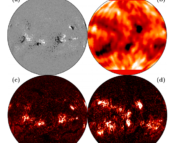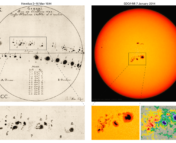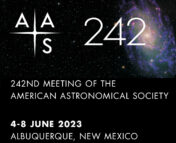Just like the book, we’ll start with a very important reminder: as interesting as the Sun is, never look at it directly with the naked eye! Doing so can permanently damage your vision (and we wouldn’t want that!).
With this important reminder out of the way, let’s introduce Dr. Ryan French—an astrophysicist at the U.S. National Solar Observatory and a very big fan of the Sun. In his new book, The Sun: Beginner’s Guide to Our Local Star, French embarks on a three part journey to explore our nearest star. This brief book starts by taking you through the history of how humanity has observed the Sun in the past few thousand years, then it dives into modern solar science and ends with tips for safely observing the Sun.
It’s an excellent, light, and portable reference for anyone interested in learning more about the Sun, even if you’ve never thought about our nearest star. It’s particularly relevant if you plan on observing the upcoming April 2024 total solar eclipse! Plus, the book is published in full color, and is absolutely chock-full of photos from historic drawings to dazzling photos from NASA.
As with any reliable reference book, French’s guide to the Sun is thorough and clearly organized, giving the reader a succinct overview of relevant topics so they can choose where they’d like to dive deeper. From stellar evolution to blackbody radiation, plasma to spectroscopy, this guide covers all the major topics you’d expect to get a sense of what’s going on in the Sun.
A particularly interesting section describes the physics of solar flares and coronal mass ejections, two solar events that can actually have quite a big impact on Earth (e.g. via space weather), but often aren’t explained in detail for fear of getting too technical. French dives in, using intuitive examples from daily life (like how lifting a book takes effort–and therefore energy–on your part, leaving the book with more gravitational potential energy) to explain complex concepts like magnetic free energy created by magnetic reconnection on the Sun.
Although this book has a heavy dose of science, it makes sure to connect back to Earth and practical effects the Sun has on our lives, like geomagnetic storms, radio blackouts, and how the Sun creates the magnificent aurora borealis. Helpful tables put the risk from solar events in context, comparing their likelihood of impacting people with other potential disasters like earthquakes and pandemics. Other handy charts detail the levels of severity possible in geomagnetic storms and solar flares, including their effects on infrastructure like satellites and power grids.
French also includes the most modern happenings in solar science, including recent findings from the incredible Parker Solar Probe, the highest-resolution image of a star other than the Sun (Antares, as seen by the European Southern Observatory’s Very Large Telescope) and “exosolar” space weather around other stars. He even includes a list of open questions in solar science, clearly showing the edges of current knowledge and hopefully inspiring others to explore these mysteries.
The last chunk of the book is all about the hands-on aspect: different ways to observe the Sun (eclipse glasses, projections, solar telescopes, NASA data), a list of common filters and what part of the Sun they’re best for seeing, and a convenient list of features to spot on the Sun (hah, get it, sunspot?). Unlike other guides that only provide a cursory glance at these tools, French clearly draws on years of experience to tell his readers about less commonly known utilities like HelioViewer, a program developed by an international team of space agencies to assist in viewing and analyzing images of the Sun.
And of course, any handbook of the Sun would be incomplete without a mention of eclipses, especially now as people are excitedly preparing and making travel plans for the April 2024 North American total solar eclipse. If you’re not located in the U.S., Mexico, or Canada, don’t fret—French provides a list of upcoming opportunities to see one of these events across the globe. Either way, if you’re planning for an eclipse, this is a great book to have in your toolkit to make the most of that cosmic experience.
Astrobite edited by: Katya Gozman and Alice Curtin
Featured image credit: Collins Astronomy
Thanks to Dr. Ryan French for providing a copy of the book for this review!




